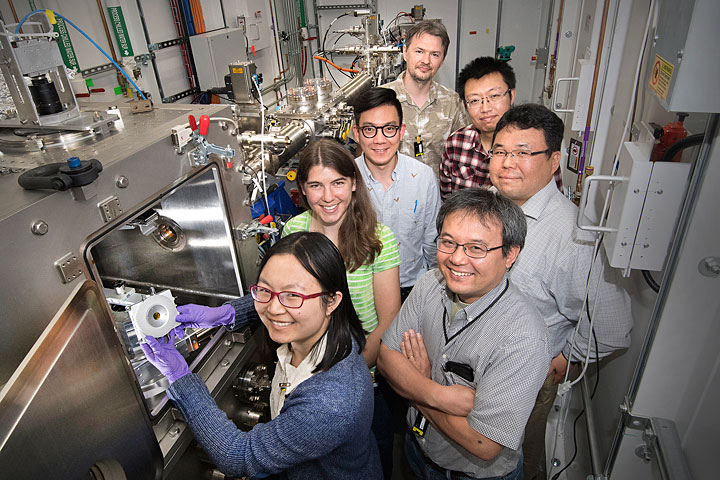How Densely Can Spheres Be Packed?
Complementary beamlines at NSLS-II provide high-resolution data for fundamental research
September 17, 2018
 enlarge
enlarge
The research team from the Rensselaer Polytechnic Institute used the Soft Matter Interfaces (SMI) beamline at NSLS-II for detailed studies on their material.
Researchers from Rensselaer Polytechnic Institute came to the National Synchrotron Light Source II (NSLS-II)—a U.S. Department of Energy (DOE) Office of Science User Facility at DOE’s Brookhaven National Laboratory—to answer a fundamental question in science, engineering, and mathematics: how densely can spherical particles be packed?
“This is an old and fundamental question,” said Sangwoo Lee, principal investigator of the study. “Once we have a good understanding of how spherical particles pack in a defined space, we can better assess the functions and properties of a wide variety of materials, including metals like aluminum.”
Combined with NSLS-II’s ultrabright x-rays, complementary experimental tools at two NSLS-II beamlines revealed the fundamental transition order of sphere packing structures. Among various research methods, the scientists used small-angle x-ray scattering (SAXS) at the Complex Materials Scattering (CMS) beamline and the Soft Matter Interfaces (SMI) beamline. While CMS enabled the researchers to quickly measure a large number of samples under various conditions in real time, SMI helped produce incredibly high resolution images of otherwise undetectable features of the material.
“CMS provides users with a tool to explore a material’s structure under changing environmental conditions, and to study how the material behaves over time,” said Masa Fukuto, lead beamline scientist at CMS. “This offers scientists the possibility to see the bigger picture of their material and, in this case, prepares them for more detailed studies on a targeted set of samples with specific material conditions.”
In this study, the researchers used the CMS beamline to measure the global behavior of their material while dramatically changing the temperature of its environment. These in situ experiments gave the researchers the possibility to screen many variations of their material in a short amount of time and define the right conditions where the hidden packing phases would be visible. To measure these phases, the scientists needed to take a closer look at the tiny features of their material at the SMI beamline. The incredible resolution power of SMI opened the door to find elusive features that are otherwise invisible.
“This group really made the most out of both beamline’s capabilities,” said Mikhail Zhernenkov, lead beamline scientists at SMI. “Without their extensive exploration of the materials’ global behavior at CMS, they would not have known where to search for these features when using SMI.”
 enlarge
enlarge
Scientists use ping pong balls to visualize the packing structure of spherical objects. (Image by Sangwoo Lee)
The study not only combined the existing capabilities of both beamlines, but also encouraged the beamline scientists to push the resolution limits of their instruments even further.
“These two beamlines are really complementary in terms of their capabilities,” Lee said. “They gave us high resolution data, so we could really understand what’s going on in our samples. I don’t think we could have made this discovery with only one beamline.”
The experiments at CMS and SMI revealed hidden phases between the known packing orders of spheres. Using the newfound knowledge, the researchers could explain when and how spheres are packed. The researchers say they are pleased to be able to provide new insight to the age-old question. Their results are published in PNAS.
This research was supported in part by the National Science Foundation through the Materials Research Science and Engineering Center program at the University of Minnesota’s Characterization Facility. Operations at NSLS-II are supported by the DOE Office of Science.
Brookhaven National Laboratory is supported by the Office of Science of the U.S. Department of Energy. The Office of Science is the single largest supporter of basic research in the physical sciences in the United States, and is working to address some of the most pressing challenges of our time. For more information, please visit science.energy.gov.
Follow @BrookhavenLab on Twitter or find us on Facebook.
2018-13133 | INT/EXT | Newsroom









